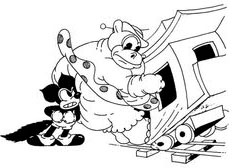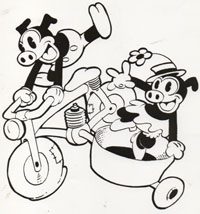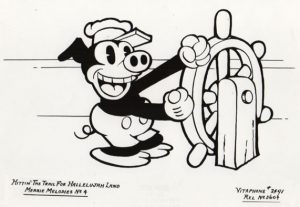During the 1931-32 film season, many in the movie industry could be excused for thinking their industry was Depression-proof. Warners was still doing well with gangster pictures. Musicals, however, were in eclipse, the only of them succeeding being those starring Eddie Cantor (for another studio).
The Warner Brothers cartoon unit was doing very well. They had just started their second series of cartoons, titled “Merrie Melodies”. We have discussed the first of these, Lady, Play Your Mandolin, in a previous article. Now, we discuss further titled from the 1931-32 season.
 Smile, Darn Ya, Smile (9/5/31). This episode continues the adventures of Foxy and his girlfriend Roxy, introduced in the preceding cartoon, on a hazardous trolley excursion and encounter with the local hobo jungle and a sedentary cow (allowing a musical interpolation of Elgar’s “Pomp and Circumstance” march when she walks). Animation fans will remember the use of the title song in “Who Framed Roger Rabbit?”, where it became the virtual theme song of Toontown. This is a “Cheer Up“ type of song – the type that Tin Pan Alley and Denmark Street ground out in great quantity as the Depression got worse. Victor records gave it to Snooks and his Memphis Ramblers, the band resident at the Paramount Hotel in New York. Columbia gave it to a Ben Selvin studio group which featured in its personnel Benny Goodman, with a vocal by Joe and Dan Mooney, the Sunshine Boys. Brunswick gave to Hal Kemp and his group of Southern college boys. The smaller companies also covered the song, both as a dance band and a vocal record.
Smile, Darn Ya, Smile (9/5/31). This episode continues the adventures of Foxy and his girlfriend Roxy, introduced in the preceding cartoon, on a hazardous trolley excursion and encounter with the local hobo jungle and a sedentary cow (allowing a musical interpolation of Elgar’s “Pomp and Circumstance” march when she walks). Animation fans will remember the use of the title song in “Who Framed Roger Rabbit?”, where it became the virtual theme song of Toontown. This is a “Cheer Up“ type of song – the type that Tin Pan Alley and Denmark Street ground out in great quantity as the Depression got worse. Victor records gave it to Snooks and his Memphis Ramblers, the band resident at the Paramount Hotel in New York. Columbia gave it to a Ben Selvin studio group which featured in its personnel Benny Goodman, with a vocal by Joe and Dan Mooney, the Sunshine Boys. Brunswick gave to Hal Kemp and his group of Southern college boys. The smaller companies also covered the song, both as a dance band and a vocal record.
Crown records (whose sleeves were emblazoned with their motto, “Two Hits For Two Bits”) issued a version by Billy “Uke” Carpenter, aka Billy Costello (familiar to cartoon fans as the original Popeye, and who has been written about in this column for the additional use of his recordings in Betty Boop cartoons). Friz Freleng would borrow gags for this cartoon from previous Warner cartoons and even from a Disney cartoon produced for M. J. Winkler, Trolley Troubles with Oswald the Lucky Rabbit. Freleng would remember the tunnel gags, used previously in two early Looney Tunes shorts, Sinkin’ in the Bathtub and Box Car Blues, and might well have remembered them years later, when they got similar use in Bugs Bunny Rides Again in the 1940’s.
 One More Time (8/1/31), a superior DeSylva, Brown and Henderson song, was widely covered in its day. Foxy is an officer of the law, directing hectic traffic and contending with a gang of local hoodlums, coming again to Roxy’s rescue. A curious topical reference has Foxy dumping a trash can of garbage on the head of a reckless-driving hippo, who reacts to the smell with the catch-line of a then-current “blindfold test” of cigarette brands (“I know – – Old Gold!”). Victor gave the song to Gus Arnheim and his Coconut Grove Orchestra, with a bubbly vocal by Bing Crosby (embed below), while Columbia gave it to Ted Lewis (including several stalwart jazz men in his personnel, among them Muggsy Spanier (cornet), George Brunies (trombone), and Benny Goodman (clarinet)). Ben Selvin’s studio band got to record it for the Harmony low-priced label. Benny Goodman was present and accounted for on the Selvin date as well – if it seems like he was getting a lot of work, he was! A quick-reading studio musician who could read anything in front of him and improvise jazz solos could pull in as much as $400 a week between radio shows and record dates. (This was in a time when people who could keep their jobs were lucky if they could earn $400 in three months.)
One More Time (8/1/31), a superior DeSylva, Brown and Henderson song, was widely covered in its day. Foxy is an officer of the law, directing hectic traffic and contending with a gang of local hoodlums, coming again to Roxy’s rescue. A curious topical reference has Foxy dumping a trash can of garbage on the head of a reckless-driving hippo, who reacts to the smell with the catch-line of a then-current “blindfold test” of cigarette brands (“I know – – Old Gold!”). Victor gave the song to Gus Arnheim and his Coconut Grove Orchestra, with a bubbly vocal by Bing Crosby (embed below), while Columbia gave it to Ted Lewis (including several stalwart jazz men in his personnel, among them Muggsy Spanier (cornet), George Brunies (trombone), and Benny Goodman (clarinet)). Ben Selvin’s studio band got to record it for the Harmony low-priced label. Benny Goodman was present and accounted for on the Selvin date as well – if it seems like he was getting a lot of work, he was! A quick-reading studio musician who could read anything in front of him and improvise jazz solos could pull in as much as $400 a week between radio shows and record dates. (This was in a time when people who could keep their jobs were lucky if they could earn $400 in three months.)
Another song heard in this picture, at about 3:35 into the film while Foxy is still pounding his beat, is “Dancing With the Daffodils (Down At the Garden Ball)”, which was recorded for Melotone records (Brunswick’s new low-price subsidiary) and by no others. The band was a studio group under the direction of Victor Young, which may have included either or both of the Dorsey Brothers.
The above two films credit Abe Lyman and his Brunswick Recording Orchestra as providing music on the track. These tracks would have to have been recorded before June of 1931, as Lyman’s band left for Chicago at that time and resumed playing in the windy city.
 You Don’t Know What You’re Doin’ (10/31/31), credits Gus Arnheim and his Brunswick Recording Orchestra on the title card. This is inexact, as the orchestra on the track sounds like Lyman’s band from the previous cartoons. The title song was not widely covered, but Arnheim did have it recorded on one of his transcribed radio recordings in a different arrangement, with vocal by Loyce Whiteman (no relation to Paul). This cartoon starts out as a night at the theater, before it becomes a demonstration of delirium tremens caused by bootleg hooch. The cartoon substitutes a new hero – Piggy, and his girlfriend Fluffy, in place of Foxy and Roxy, whom the screen sees no more. Soundtrack features Orlando “Slim” Martin on slide trombone, whose gabbling style (which sounds like “Uggedy Uggedy Uggedy” with all the consonants surgically removed) is used to voice a car intoxicated by pouring the potent brew into the radiator, and which inspired sound effects used in numerous subsequent cartoons (including well into the 1940’s in Bugs Bunny Gets the Boid, when Bugs manipulates the Adam’s apple of Beaky Buzzard). Animation is exceptionally creative for a Harman-Ising product, with the entire skyline bending and squashing in rhythm to the sprightly music.
You Don’t Know What You’re Doin’ (10/31/31), credits Gus Arnheim and his Brunswick Recording Orchestra on the title card. This is inexact, as the orchestra on the track sounds like Lyman’s band from the previous cartoons. The title song was not widely covered, but Arnheim did have it recorded on one of his transcribed radio recordings in a different arrangement, with vocal by Loyce Whiteman (no relation to Paul). This cartoon starts out as a night at the theater, before it becomes a demonstration of delirium tremens caused by bootleg hooch. The cartoon substitutes a new hero – Piggy, and his girlfriend Fluffy, in place of Foxy and Roxy, whom the screen sees no more. Soundtrack features Orlando “Slim” Martin on slide trombone, whose gabbling style (which sounds like “Uggedy Uggedy Uggedy” with all the consonants surgically removed) is used to voice a car intoxicated by pouring the potent brew into the radiator, and which inspired sound effects used in numerous subsequent cartoons (including well into the 1940’s in Bugs Bunny Gets the Boid, when Bugs manipulates the Adam’s apple of Beaky Buzzard). Animation is exceptionally creative for a Harman-Ising product, with the entire skyline bending and squashing in rhythm to the sprightly music.
 Hittin’ the Trail For Hallelujah Land (11/28/31) has been written up on this site before, as the earliest of the “Censored 11″. It marked the swan song for Piggy, after only two episodes – generally, Harman and Ising would thereafter avoid using recurring characters for the Merrie Melodies, despite a trio of “Goopy Geer” appearances to come, and frequent reuse of animation from previous episodes allowing incidental characters to have repeated appearances. Besides the title song, which does not appear to have been recorded commercially by anybody, the soundtrack uses the old standard favorites, “Camptown Races”, and a current popular favorite, “Just a Blue-Eyed Blonde”, which was recorded by The High Hatters on Victor. The film centers around the stereotype tropes of African-Americans being afraid of graveyards, and such like.
Hittin’ the Trail For Hallelujah Land (11/28/31) has been written up on this site before, as the earliest of the “Censored 11″. It marked the swan song for Piggy, after only two episodes – generally, Harman and Ising would thereafter avoid using recurring characters for the Merrie Melodies, despite a trio of “Goopy Geer” appearances to come, and frequent reuse of animation from previous episodes allowing incidental characters to have repeated appearances. Besides the title song, which does not appear to have been recorded commercially by anybody, the soundtrack uses the old standard favorites, “Camptown Races”, and a current popular favorite, “Just a Blue-Eyed Blonde”, which was recorded by The High Hatters on Victor. The film centers around the stereotype tropes of African-Americans being afraid of graveyards, and such like.

Red Headed Baby (12/26/31). This song was covered twice. Victor gave it to Gene Kardos and his Orchestra , which was playing at the Gloria Palast in the Yorkville section of Manhattan, and by Fred “Sugar” Hall and his Sugar Babies, issued on the cheap Harmony, Velvet Tone, and Clarion labels under the pseudonym of “Arthur River and his Novelty Orchestra”. This cartoon is an early example of a “midnight in a toy shop” scenario, appropriate for the holiday season release – a trope introduced in and inspired by the song “The Toymaker’s Dream” (not in the film), written by Ernie Golden, and recorded by Golden’s Orchestra, other orchestras, and the singer Vaughn De Leath.
Coming: More Merrie Melodies into 1932.


 James Parten has overcome a congenital visual disability to be acknowledged as an expert on the early history of recorded sound. He has a Broadcasting Certificate (Radio Option) from Los Angeles Valley College, class of 1999. He has also been a fan of animated cartoons since childhood.
James Parten has overcome a congenital visual disability to be acknowledged as an expert on the early history of recorded sound. He has a Broadcasting Certificate (Radio Option) from Los Angeles Valley College, class of 1999. He has also been a fan of animated cartoons since childhood.











































You’ve outdone yourself this time! These were great ways to use the pop tunes owned by Warner Brothers, and some of this music is just right for animated cartoons. Aside from Max Fleischer cartoons, Warner Brothers were some of the jazziest and jauntiest cartoons out there. “YOU DON’T KNOW WHAT YOU’RE DOING” becomes an ear worm after a while, especially how it is arranged for the cartoon, as are the other titles mentioned here, especially “RED-HEADED BABY”. Keep ’em comin’! I only wish that Warner Brothers would issue, perhaps a novelty disk or set of disks on original versions of songs and music that appears in their cartoons, on up to and through the classical pieces that we’ve heard. That was the point of the “BUGS BUNNY ON BROADWAY” shows and the HOLLYWOOD JAZZ double-CD set released a number of years ago.
These cheery Depression-era songs never fail to bring a smile to my face. “Smile, Darn Ya, Smile!” is similar to “Cheer Up!” sung by Old Mother Hubbard’s dog (imitating Maurice Chevalier) in the Ub Iwerks ComiColor cartoon.
Keep dropping that needle, accentuate the positive, and let a smile be your umbrella on a rainy, rainy day!
When you’re rooting for Jazz (and I’m rooting right along with you) remember that it was organized crime that promoted it. The good folks in the government and in churches viewed Jazz as whorehouse music, rightly because that is where it was born. Scott Joplin, America’s first original composer, was not allowed to join the American Federation of Musicians as his music was viewed as “whorehouse music.”
Ironically, the mob did more to advance Black culture and music than did the churches and the government both of which were bust suppressing it. There is a saying as old as the first temple, “The nearer the church/synagogue/temple the farther from Allah/The Buddha/God.”
Today of course Jazz is heard in churches. That’s because the form is dead.
“You don’t what you’re doin'” has been re-drawn and colorized as well as some other b&w golden age cartoons shown on YouTube with little to no information. Are these officially done by the Studios or is it a fan thing? This cartoon both black and white and re-drawn colorized are on YouTube with ZERO information on or about the r.d. colorized version. I was hoping you or someone could shed light on that.
Just a Blue-Eyed Blonde – so the musical structure is used for the majority of the cartoon in various speeds
Camptown Races – mainly for the do da do da for Uncle Tom going to and from the ferry
I was wishing Hittin was actually a real song in its own right, oh well